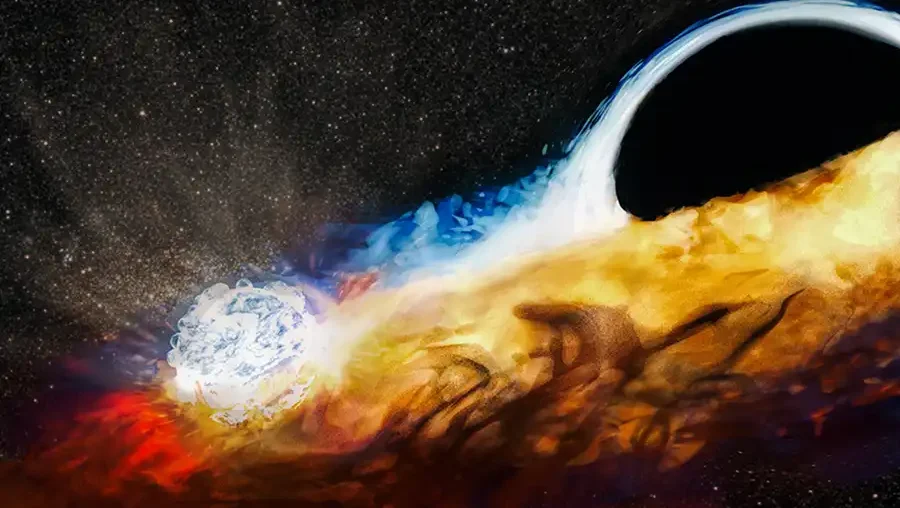
NASA / CXC / SAO and Soheb Mandhai / The Astro Phoenix
In 2019 a supermassive black hole ate a star. It’s incredible that such an incredible event is now commonplace — not in individual galaxies, where such stellar meals happen only every 10,000 to 100,000 years, but in our telescopes, through which astronomers can monitor millions of galaxies to observe their feeding habits.
But in the course of studying this particular stellar feast, Matt Nicholl (Queen’s University Belfast, UK) and colleagues discovered something else: bright spikes of X-rays that recurred roughly every 48 hours. Those kinds of spikes have been observed elsewhere, and astronomers call them quasi-periodic emissions — a vague term that reflects the fact that we don’t know why they happen.
Now, they have an important clue. The Zwicky Transient Facility, a wide field-of-view camera that scans the whole sky every two days, found a visible flash of light that it dubbed AT2019qiz on September 19, 2019. That burst came from the center of a barred spiral galaxy some 210 million years ago, taking that long to travel to Earth. The flare marked the end of a star that had passed too close to that galaxy’s million-solar-mass black hole, and it was sheared apart in the extreme gravitational field.

PanSTARRS, NSF/Legacy Survey/SDSS
The black hole takes time to eat, and the stellar gas was still swirling inward as astronomers turned the Chandra X-ray Observatory to watch high-energy emission from the meal in 2023. They found an unexpected spike in X-ray emission that prompted follow-up observations with the Neutron Star Interior Composition Explorer (NICER) onboard the International Space Station as well as observations from two other space telescopes, the Neil Gehrels Swift Telescope and India’s AstroSat.
In all, they found nine X-ray bursts that recurred roughly every two days. Hubble Space Telescope observations showed that the emissions are coming from a source less than 82 light-years across — in other words, too small to be a star cluster in the galaxy’s center. More likely, the source is material swirling around the black hole in an accretion disk.

NASA / CXC / Queen’s Univ. Belfast / M. Nicholl et al.; Image processing: NASA / CXC / SAO / N. Wolk
Nicholl’s team thinks these bursts mark the orbit of something crossing the accretion disk: another star.
“We don’t expect many stars orbiting this close to a black hole,” says Nicholl. “We think that most of the stars are sitting much further away, but every now and again they can deflect each other towards the black hole.”
If a single star were to fall toward the black hole, the strong gravity would shred it to pieces. But if a stellar pair falls in, three-body gravitational interactions mean that one star can be captured into orbit while its longtime companion is thrown out of the system altogether.
“These captures are rare,” Nicholl notes. But once bound to the black hole, the star stays there, its orbit only slowly decaying. “At any given time, a black hole at the center of an average galaxy will have about one star in a tight orbit like this.”
There’s no way for our telescopes to pick up the faint glow of a solo star so far away. But if, separately, another object falls into the black hole, its material spreads out into a disk and begins to interact with the captured star.
“However, this is just our simple picture,” Nicholl cautions. “Now that we think we know what to look for, we can observe what fraction of tidal disruption events have quasi-periodic oscillations, and this will let us actually measure how common these close orbiting stars really are, to test this theory.”
Time will tell, but they could be in luck: The fact that they found these repeating X-ray bursts by accident means they might be common in the universe at large.

